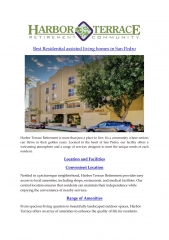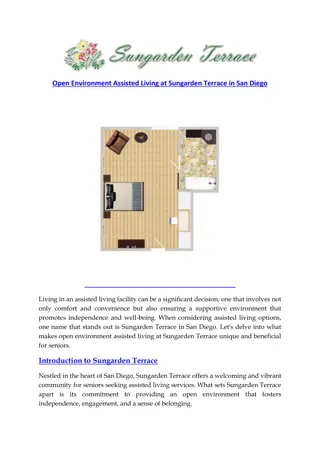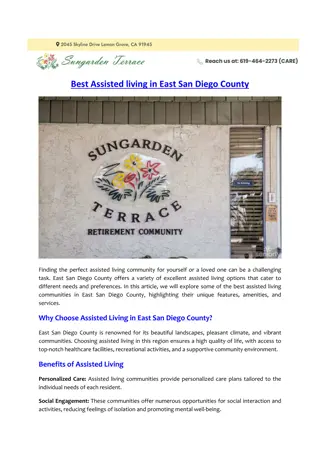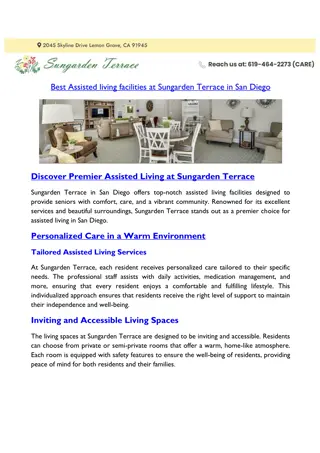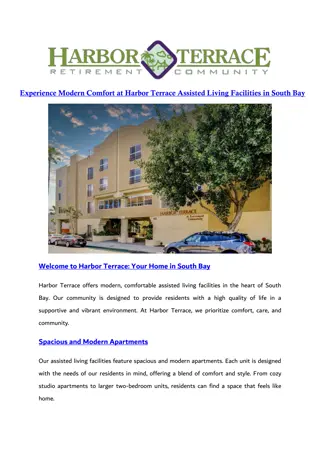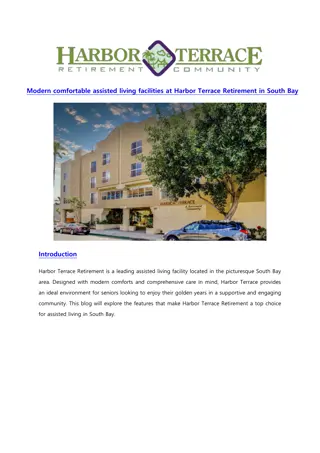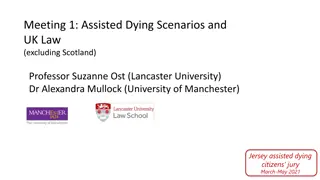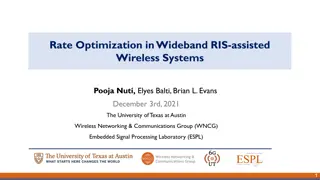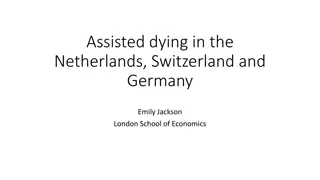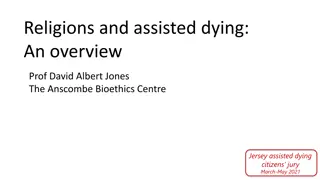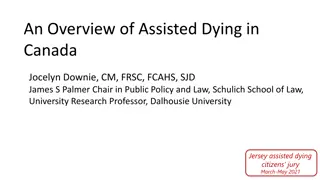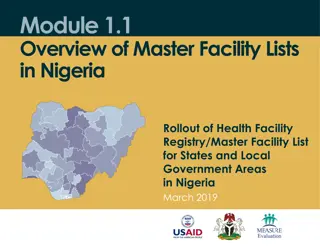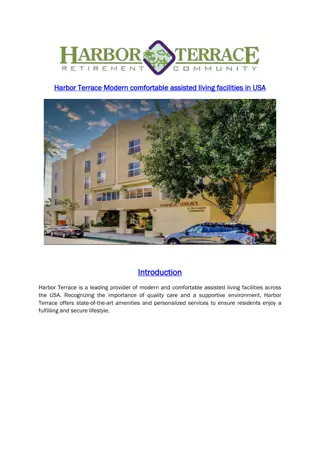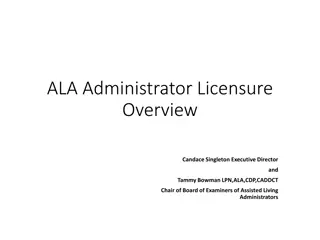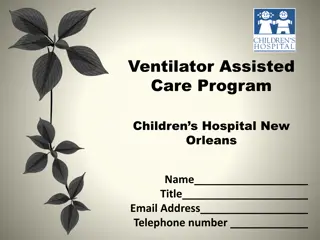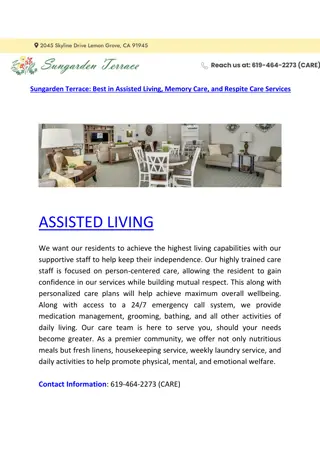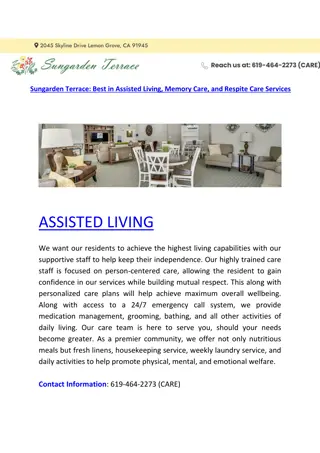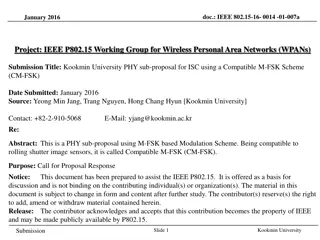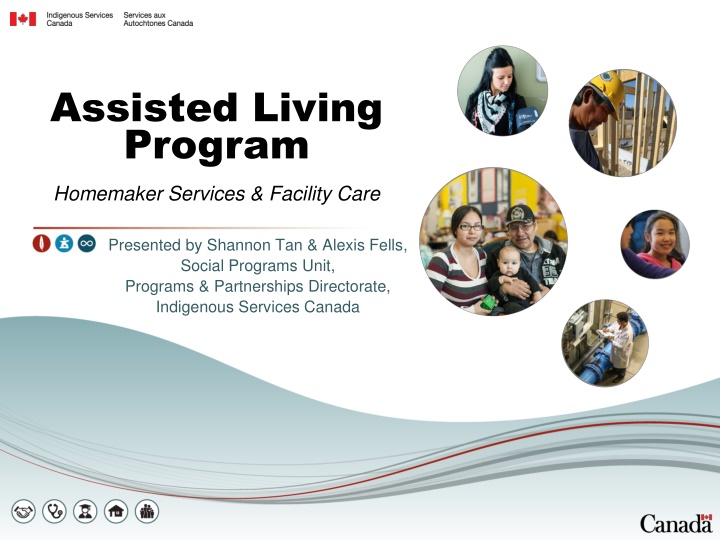
Homemaker Services Eligibility and Application Process
Learn about the eligibility criteria for the Assisted Living Program's Homemaker Services, including non-medical social support services and respite care. Explore the application process for accessing Homemaker Services, which involve financial assessment and assessment by a designated assessor.
Download Presentation

Please find below an Image/Link to download the presentation.
The content on the website is provided AS IS for your information and personal use only. It may not be sold, licensed, or shared on other websites without obtaining consent from the author. If you encounter any issues during the download, it is possible that the publisher has removed the file from their server.
You are allowed to download the files provided on this website for personal or commercial use, subject to the condition that they are used lawfully. All files are the property of their respective owners.
The content on the website is provided AS IS for your information and personal use only. It may not be sold, licensed, or shared on other websites without obtaining consent from the author.
E N D
Presentation Transcript
Assisted Living Program Homemaker Services & Facility Care Presented by Shannon Tan & Alexis Fells, Social Programs Unit, Programs & Partnerships Directorate, Indigenous Services Canada
Assisted Living Eligibility Someone must be ordinarily resident on-reserve Income Tested Homemaker Services Non-medical social support services Allows clients to stay in their home as long as possible Respite care for family members regularly helping with care 2
Homemaker Services Eligible Expenditures may include: Meal programs (meal planning, meal preparation) Day programs Attendant care (e.g. accompanying to groceries or appointment) Short-term respite care for caregiver Group care Laundry Ironing Carrying/chopping/stacking wood Home management/house cleaning (e.g. making beds, dusting, vacuuming) Minor home maintenance (e.g. fixing doorknob) -> not major repairs Non-medical transportation (e.g. going for groceries) 3
Homemaker Services Application Process BSDW/HS provides client with application for Homemaker Services (SA 215), client completes Section A of form SA 215 form parts: one to be done by client Financial information (if client has income and can help with costs) Service provider cost section (after the assessment is done) BSDW/HS arranges for an assessor to visit client Assessor can be health nurse, community nurse, or community health rep Assessor will meet with client and determine what they need (e.g. client isn t able to prepare their own meals, needs someone to help with laundry, etc) Assessor fills out Homemaker Services Evaluation (901-30) Once client is approved for homemaker services, the In-Home Care Services Application must be completed 4
Homemakers Services Financial Part of Application As part of the application, there is a financial part. In many cases the client will not have to contribute to the cost of care If they are getting the following, they do not need to contribute to costs: Widow s/Spouse s Allowance GIS War Veterans Income Assistance or PWD If they are getting the following, then they may need to contribute to costs but the most they would have to pay is $300/month: Employment income/other income CPP Private Pension funds 5
Homemaker Services - Reviews Reviews and follow up visits must be conducted by the assessors to re- evaluate clients needs Reviews must be done in person Review must take place every 6 months What Happens During a Review? A visit to the client in the home by assessor Assessor checks if there are any changes to client s care needed (e.g. client needs more/less care, add another hour per week, etc) Completion of Homemaker Services Evaluation form (901-30), even if there is no change The evaluation form says max service time is 6 months, so assessments should be done every 6 months 6
Institutional/Facility Care What is this? Financial assistance for eligible Individuals ordinarily resident on-reserve (basically anyone who was ordinary living in community, and only had to go off-reserve in order to access services) Does not matter if they are going to a facility off-reserve or out of community Who is eligible for it? Someone ordinarily resident on-reserve before entering hospital or facility care Either Status, or Canadian Citizen/Permanent Resident (if Non-Status) Not dependent on band membership or Status Who pays? Part of the Assisted Living Program if an individual is eligible the band pays up front, then reports it on their Assisted Living report, and gets reimbursed by ISC 7
Institutional/Facility Care Process Referral for an applicant for facility care can be started by anyone, including the client, friend, family, doctor, hospital social worker, etc. Application Process 1) Case is opened by Nation s health representative or BSDW 2) Client completes Medical Release form with their doctor (SA 115) 3) Must arrange for Local health authority Home and Community Care Case Manager to meet client and assess their situation 4) Home and Community Care Case Manager will complete Application and Assessment form (HLTH 1.1) and Financial Profile and Calculations form (HLTH 1.6) noting the level of care They will determine the level of care and ensure that the facility is the right one for the client s needs 5) Submit all forms to ISC and get approval (if eligible) 8
Facility Care What Does the BSDW Do? The Nation Health Rep or BSDW may connect between the client/family and the local health authority rep to get forms/information BSDW/health rep will submit all completed forms to ISC at aandc.bsdwsupportbc-tsdbsoutiencb.aadnc@canada.ca BSDW/health rep will note approval dates, and contact ISC each year to update on client situation (e.g. no changes, rates have increased, client deceased, etc) Work with reporting to complete Assisted Living reports, and submit to ISC for reimbursement Band covers costs up front, reports, then ISC reimburses A separate IA file should be maintain if the client is also on IA 9
Institutional/Facility Care Client Files Client Files for Facility Care Should Include: Completed Medical Release and Report (SA 115) Application and Assessment Form (HLTH 1.1) Financial Profile and Calculations Form (HLTH 1.6) Completed Client Admission Form Confirmation/Approval letter from ISC Case notes and other documentation as required How Long Until Approval? Once all forms are properly completed and submitted, generally within a week Care costs can be backdated approval letter will note the date of admission 10
Thank You! Any Questions? Call us! 1-888-440-4080 Email Us! Aadnc.tsdbsoutien-bsdwsupport-bc.aandc@canada.ca Alexis Fells and Shannon Tan 11


